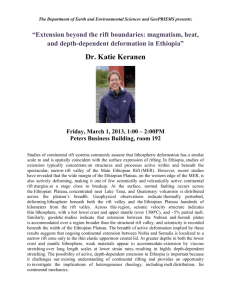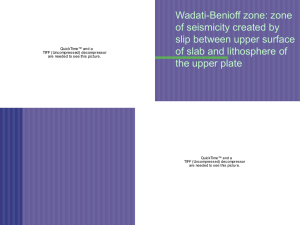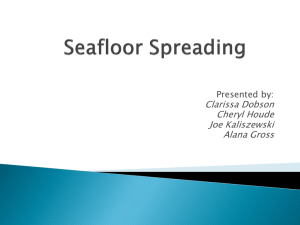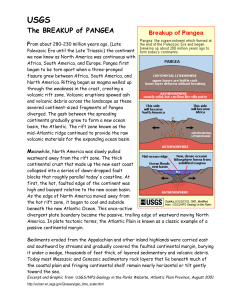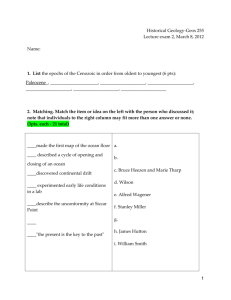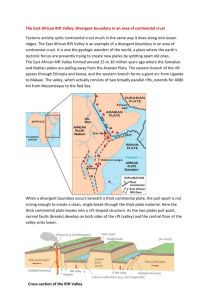Introductory Lecture
advertisement
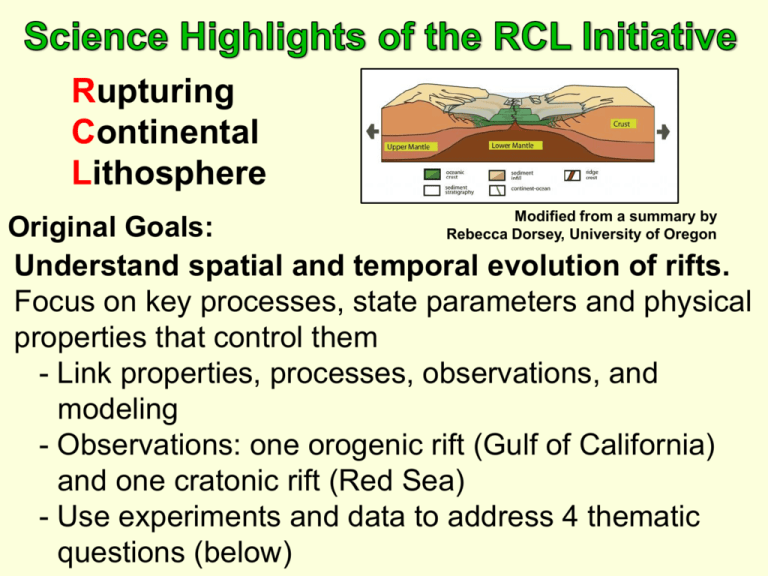
Rupturing Continental Lithosphere Modified from a summary by Rebecca Dorsey, University of Oregon Original Goals: Understand spatial and temporal evolution of rifts. Focus on key processes, state parameters and physical properties that control them - Link properties, processes, observations, and modeling - Observations: one orogenic rift (Gulf of California) and one cratonic rift (Red Sea) - Use experiments and data to address 4 thematic questions (below) (and ancillary modeling studies) Gulf of California / Salton Trough Red Sea Region Source: MARGINS 2009 Review - RCL Summary www.nsf-margins.org/Review2009/ Rupturing Continental Lithosphere Original Scientific Questions Summary by Rebecca Dorsey University of Oregon 1. What forces drive rift initiation, localization, propagation and evolution ? 2. How does deformation vary in time and space, and why ? 3. How does crust evolve, physically and chemically, as rifting proceeds to spreading ? 4. What is the role of fluids and magmatism in continental extension ? New results that change the way we think about continental rifting, rupture, and underlying controls 1. Styles of Extension Important factors: (a) Different styles of extending the lithosphere (b) Structural evolution of normal faults in rifts (c) Pre-rift tectonic histories (subduction, collision) (d) Faulting style controls shape of sedimentary basins Modified from Gonzales-Escobar, 2013 New results that change the way we think about continental rifting, rupture, and underlying controls 2. Role of Sedimentation Sediments not just a passive record of earth history. Exert a direct control on rift process, magmatism, crustal composition, formation of ocean basins. Includes critical link to interior fluvial system (Colorado River) – “source to sink”. Can create new type of hybrid crust at Ocean – Continent Transition. New results that change the way we think about continental rifting, rupture, and underlying controls 3. Role of Rift Obliquity Important factors: (a) Oblique extension and strike-slip faults (b) Relationship between the orientation of the rift and relative motion direction (° of obliquity) (c) Rift obliquity affects resulting morphology of the rift zone (Gulf of CA vs. Red Sea) New results that change the way we think about continental rifting, rupture, and underlying controls 4. Role of Magmatism Pre-rift volcanism depletes the upper mantle - leads to less syn-rift magmatism Less magma makes lithosphere effectively stronger, so deformation migrates (not localized). This produces a WIDE RIFT zone and longer time to rupture. New results that change the way we think about continental rifting, rupture, and underlying controls 1. Styles of Extension Important factors: (a) Different styles of extending the lithosphere; (b) Structural evolution of normal faults in rifts; (c) Pre-rift tectonic histories (subduction, collision); (d) Faulting style controls shape of sedimentary basins. 2. Role of Sedimentation Sediments not just a passive record of earth history. Exert a direct control on rift process, magmatism, crustal composition, formation of ocean basins. Includes critical link to interior fluvial system (Colorado River) – “source to sink”. Can create new type of hybrid crust at Ocean – Continent Transition. 3. Role of Rift Obliquity Important factors: (a) Oblique extension and strike-slip faults; (b)Relationship between the orientation of the rift and relative motion direction (° of obliquity); (c) Rift obliquity affects resulting morphology of the rift zone (Gulf of CA vs. Red Sea). 4. Role of Magmatism Pre-rift volcanism depletes the upper mantle less syn-rift magmatism. Less magma makes lithosphere effectively stronger, so deformation migrates (not localized). This produces a WIDE RIFT zone and longer time to rupture. Modified from Gonzales-Escobar, 2013

